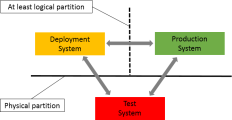Test and Production Systems - Best Practices
An Automation Engine system is an environment that can be handled and monitored from the Automic Web Interface. This includes components such as the Automation Engine and the Agents, their computers, applications and processing which can be defined via objects.
This page includes the following:
Overview
It strongly recommended working with three Automation Engine systems:
- A DEVELOPMENT system, which serves to plan and create the objects which represent your processes
- A TEST system to test all processes
- A PRODUCTION system where you execute your daily business processes
There is a clear philosophy behind this three-system environment. Your business processes are extremely important. Simply changing or adding Workflows or system settings might put them at risk so you should test them in a separate system environment before they can be used for productive operation.
Three-System Environment
The following illustration shows how the three Automation Engine systems work together:
In the PRODUCTION system, you can use a separate client for the DEVELOPMENT system.
The TEST and PRODUCTION systems must be physically separated in any case. This ensures that new procedures can be tested without putting your business processes at risk.
In the illustration above, partition means:
- Two Automation Engine systems
- Each Automation Engine system has its own Automation Engine, Agents, etc.
- Both systems use different computers
- Both are equipped with the same hardware and software (OS, database, third-party software, etc.)
- Optimally, the Automation Engine systems run in different networks
- The same authorizations and Automation Engine settings (variables, INI files etc.) apply for both systems
- The TEST system has the same objects as the PRODUCTION system
- Ideally, the TEST system should be as close to identical as possible to the PRODUCTION system
These settings ensure that newly created Jobs are tested under productive conditions. The impact of modifications can be optimally tested in a TEST system. Updates to new Automation Engine versions, Operating Systems and databases can be carefully planned and tested with the most obvious advantage still being that your PRODUCTION system is not put at risk. Improvements and modifications are only transferred to the PRODUCTION environment after extensive testing.
Maintaining Your Automation Engine Systems
Regularly check compliance with the above rules and maintain the Automation Engine database on a regular basis using the Automation Engine utilities and the relevant database-specific tools.
Objects can easily be transferred between the different Automation Engine systems using the Transport Case. As opposed to imports, the Transport Case is designed to transport numerous objects to an Automation Engine system. Extensive tests in the TEST system are always recommended before objects are transferred to the PRODUCTION system.
Analyze the log files of all Automation Engine systems. This is also possible in an automated form using a job that filters particular keywords (such as "error") with the script element PREP_PROCESS_FILE.
See also:
